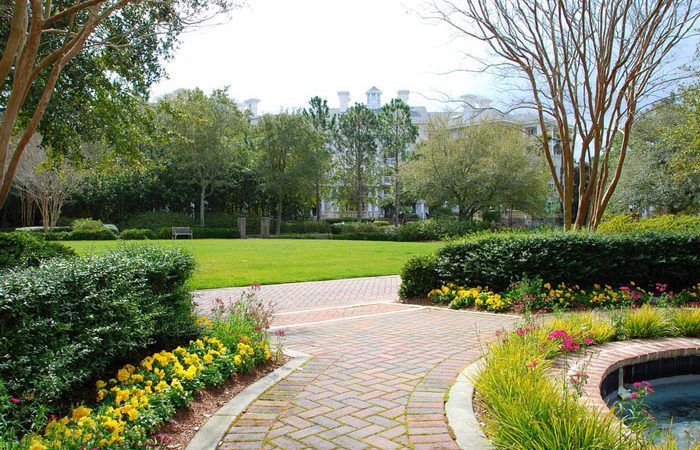
Edging your garden provides a clean crisp look. Your garden borders will stand out when there’s a clean edge between the planting area and your landscape paths, driveway, sidewalk, and your lawn.
Common edging, such as stone, wood, or brick, provide an optimal appearance keeping the plants in the garden bed while keeping the lawn out, but it isn’t always attractive. Fix that with plants!
Achillea tomentosa (Woolly Yarrow)
Compact with brighter yellow blooms than the species. Reaches 8 inches tall. Mat-forming perennial for early summer and early fall. Grayish-green leaves are linear, woolly, and pinnatifid. This heat and drought tolerant perennial has a fiberous root system and can become invasive. Divide to maintain. Butterflies are attracted to this plant. Good cut flower that dries well, too. Sometimes referred to as Achillea tomentosa ‘Aurea’.
Aegopodium Podagraria (Goutweed)
The Bishop’s Weed makes a beautiful border for a bed of shrubs or flowers if it is not allowed to spread too freely. It grows to the best advantage when used to cover waste ground or shady places where grass will not grow. It is well used in the narrow strips of soil between the foundation wall and a sidewalk.
Ajuga reptans (Carpet Bugle)
Slow spreading groundcover. Forms a dense, lusterous mat of rosette clumps of grey-green leaves with cream-colored margins and markings. Bears 3- to 4-inch spikes of bluish-purple flowers from spring to early summer. Able to withstand damp, shaded soil. Nice contrast with Hostas, Pachysandra and Ferns.
Alyssum saxatile compactum (Dwarf Goldentuft)
The Alyssums are indispensable plants for the rock garden, especially where plants are needed to droop over the rocks. They are planted along sidewalks in hanging baskets, and as groups or edges for the border. The annuals, being sweet scented, they are also used for cutting purposes and are good for Winter blooming.
Arabis alpina (Alpine Rockcress)
It is a splendid rock garden plant, growing where it will droop over the rocks. In borders, it should be used to cover bare spots. The flowers are sweet-scented and are valuable for cutting purposes. It is a neat plant wherever grown.
Bellis perennis (English Daisy)
Large flowered variety of the species, in white, pink and red, 3-inch diameter blooms. The common low growing daisy, found in lawns. Cultivars are much larger and showier. Good container plant for the balcony.
Important Info : Mulch in areas with cold winters.
Aubrietia deltoides (Purple Rockcress)
Early in the Spring, our eyes search for color in the garden. We grow the Rock Cress (Axabis) for white, Golden Alyssum for yellow and Aubrietia for purple, rose and lavender. But as a matter of fact, few persons have grown the Aubrietias because they have not known of them although the catalogs list the plants.
Campanula carpatica
‘White Clips’ is synonymous with ‘Weisse Clips’, see ‘Weisse Clips’ for more information. C. carpatica produces many variants, but all the cultivars are low-growing, rarely more than eight to twelve inches in height, and usually lower. All the cultivars are clump or mat forming, putting forth dentated leaves, oval or heart-shaped and sending up stems of tubular, upturned, star-shaped flowers in shades from deep violet through the blues to white. Vast group of plants in a wide variety of shapes and sizes. Handsome blooms, typically bell- shaped, blue flower from spring to fall. Leaves at base of plant are larger and broader than stem leaves. Uses for campanulas are as diverse as the varieties available. Showcase smaller varieties where they may be appreciated – in rock niches, close to a path. Trailing species make great ground covers and hanging baskets. Upright species should be planted in sweeping drifts in the perennial border or naturalized under trees. These spring to fall flowering beauties prefer rich, well drained soil and full to partial sun.
Cerastium tomentosum (Snow-in-summer)
These plants are invaluable for the rockery or as an edging for beds and borders. They are also excellent to plant in dry, sunny places as a carpet covering for graves or steep banks. The leaves are as valuable as the flower.
Dianthus deltoides (Maiden Pink)
Dianthus deltoides is a mat-forming species pink with shiny, dark green, lance-shaped leaves. Bears solitary, scentless, single, white, deep pink, or red flowers, to 3/4 inch wide, often with darker centers, in summer. Self-sows prolifically.
Dianthus plumarius (Grass Pink)
Festuca glauca (Blue Fescue)
Heuchera sanguinea (Coral-bells)
Iberis sempervirens (Evergreen Candytuft)
Papaver nudicaule (Iceland Poppy)
Phlox subulata (Moss Phlox)
Phlox procumbens (Hairy Phlox)
Primula veris (Cowslip Primrose)
Sedum reflexum (Jenny Stonecrop)
Sedum stoloniferum (Running Stonecrop)
Statice Armeria (Thrift)
Stellaria Holostea (Greater Stichwort or Starwort)
Tunica Saxifraga (Tunicflower)
Veronica incana (Woolly Speedwell)
Veronica Teucrium (Rock Speedwell)
Viola, in variety (Violas)

